Bacterial Adhesion on Glass–Ionomer Cements and Micro/Nano Hybrid Composite Dental Surfaces
Abstract
1. Introduction
2. Materials and Methods
2.1. Bacteria and Growth Conditions
2.2. Material Properties of Dental Surfaces
2.3. Roughness Measurements
2.4. Contact Angle Measurements
2.5. Zeta Potential Measurements
2.6. X-Ray Diffraction
2.7. Scanning Electron Microscopy with Energy Dispersice X-ray Spectroscopy
2.8. Color Measurements
2.9. Adherence of Black Tea and Red Wine on Dental Surface
3. Results
3.1. Growth of Bacteria
3.2. Roughness
3.3. Contact Angle
3.4. Zeta Potential
3.5. XRD and EDS Analysis
3.6. Color Parameters
3.7. Bacterial Adhesion Rate Measurement
3.8. SEM Micrographs
3.9. Influence of Different Substances (Wine, Black Tea)
4. Discussion
5. Conclusions
Author Contributions
Funding
Institutional Review Board Statement
Informed Consent Statement
Data Availability Statement
Acknowledgments
Conflicts of Interest
Abbreviations
| CIE | Commission Internationale de l’Eclairage |
| ΔE | color difference |
| SEM | scanning electron microscope |
| BHI | brain–heart infusion |
| IX | Fuji conventional |
| Fil | Fuji hybrid EQUIA Forte |
| TE Econom | Micro hybrid composite |
| Tetric Evo Ceram | Nano hybrid composite |
| GIC | Glass–ionomer cement |
| Ra | arithmetic average roughness |
| Rq | root mean square roughness |
| ζ | zeta potential |
References
- Sturz, C.R.; Faber, F.-J.; Scheer, M.; Rothamel, D.; Neugebauer, J. Effects of various chair-side surface treatment methods on dental restorative materials with respect to contact angles and surface roughness. Dent. Mater. J. 2015, 34, 796–813. [Google Scholar] [CrossRef] [PubMed]
- Rosentritt, M.; Hahnel, S.; Gröger, G.; Mühlfriedel, B.; Bürgers, R.; Handel, G. Adhesion ofStreptococcus mutans to various dental materials in a laminar flow chamber system. J. Biomed. Mater. Res. Part B Appl. Biomater. 2008, 86, 36–44. [Google Scholar] [CrossRef] [PubMed]
- Hahnel, S.; Rosentritt, M.; Bürgers, R.; Handel, G. Surface properties and in vitro Streptococcus mutans adhesion to dental resin polymers. J. Mater. Sci. Mater. Electron. 2008, 19, 2619–2627. [Google Scholar] [CrossRef] [PubMed]
- Cilli, R.; De Mattos, M.C.R.; Honório, H.M.; Rios, D.; De Araujo, P.A.; Prakki, A. The role of surface sealants in the roughness of composites after a simulated toothbrushing test. J. Dent. 2009, 37, 970–977. [Google Scholar] [CrossRef]
- dos Santos, P.H.; Pavan, S.; Suzuki, T.Y.; Briso, A.L.; Assunção, W.G.; Sinhoreti, M.A.; Correr-Sobrinho, L.; Consani, S. Effect of fluid resins on the surface roughness and topography of resin composite restorations analyzed by atomic force microscope. J. Mech. Behav. Biomed. Mater. 2011, 4, 433–439. [Google Scholar] [CrossRef]
- Nishitani, Y.; Yoshiyama, M.; Donnelly, A.; Agee, K.; Sword, J.; Tay, F.; Pashley, D. Effects of Resin Hydrophilicity on Dentin Bond Strength. J. Dent. Res. 2006, 85, 1016–1021. [Google Scholar] [CrossRef]
- Namen, F.; Galan, J., Jr.; De Oliveira, J.F.; Cabreira, R.D.; Filho, F.C.E.S.; Souza, A.B.; De Deus, G. Surface properties of dental polymers: Measurements of contact angles, roughness and fluoride release. Mater. Res. 2008, 11, 239–243. [Google Scholar] [CrossRef]
- Nassar, U.; Meyer, A.E.; Ogle, R.E.; Baier, R.E. The effect of restorative and prosthetic materials on dental plaque. Periodontology 2000 1995, 8, 114–124. [Google Scholar] [CrossRef]
- Quirynen, M.; Van Der Mei, H.C.; Bollen, C.M.L.; Bossche, L.H.V.D.; Doornbusch, G.I.; Van Steenberghe, D.; Busscher, H.J. The Influence of Surface-Free Energy on Supra- and Subgingival Plaque Microbiology. An In Vivo Study on Implants. J. Periodontol. 1994, 65, 162–167. [Google Scholar] [CrossRef]
- Muller, R.; Ruhl, S.; Hiller, K.-A.; Schmalz, G.; Schweikl, H. Adhesion of eukaryotic cells andStaphylococcus aureus to silicon model surfaces. J. Biomed. Mater. Res. Part A 2008, 84, 817–827. [Google Scholar] [CrossRef]
- Verran, J.; Maryan, C.J. Retention of Candida albicans on acrylic resin and silicone of different surface topography. J. Prosthet. Dent. 1997, 77, 535–539. [Google Scholar] [CrossRef]
- Hahn, R.; Weiger, R.; Netuschil, L.; Bruch, M. Microbial accumulation and vitality on different restorative materials. Dent. Mater. 1993, 9, 312–316. [Google Scholar] [CrossRef]
- Adamczyk, E.; Spiechowicz, E. Plaque accumulation on crowns made of various materials. Int. J. Prosthodont. 1990, 3, 284–291. [Google Scholar]
- Silikas, N.; Kavvadia, K.; Eliades, G.; Watts, D. Surface characterization of modern resin composites: A multitechnique approach. Am. J. Dent. 2005, 18, 95–100. [Google Scholar]
- Teughels, W.; Van Assche, N.; Sliepen, I.; Quirynen, M. Effect of material characteristics and/or surface topography on biofilm development. Clin. Oral Implant. Res. 2006, 17, 68–81. [Google Scholar] [CrossRef]
- Ten Bosch, J.J.; Coops, J.C. Tooth color and reflectance as related to light scattering and enamel hardness. J. Dent. Res. 1995, 74, 374–380. [Google Scholar] [CrossRef]
- Joiner, A.; Jones, N.; Raven, S. Investigation of Factors Influencing Stain Formation Utilizing an in Situ Model. Adv. Dent. Res. 1995, 9, 471–476. [Google Scholar] [CrossRef]
- Paravina, R.D.; Ghinea, R.; Herrera, L.J.; Bona, A.D.; Igiel, C.; Linninger, M.; Sakai, M.; Takahashi, H.; Tashkandi, E.; Perez, M.D.M. Color Difference Thresholds in Dentistry. J. Esthet. Restor. Dent. 2015, 27, S1–S9. [Google Scholar] [CrossRef]
- Bayoudh, S.; Othmane, A.; Ponsonnet, L.; Ben Ouada, H. Electrical detection and characterization of bacterial adhesion using electrochemical impedance spectroscopy-based flow chamber. Colloids Surf. A Physicochem. Eng. Asp. 2008, 318, 291–300. [Google Scholar] [CrossRef]
- Di Bonaventura, G.; Piccolomini, R.; Paludi, D.; D’Orio, V.; Vergara, A.; Conter, M.; Lanieri, A. Influence of temperature on biofilm fo rmation by Listeria monocytogenes on various food-contact surfaces: Relationship with motility and cell surface hydrophobicity. J. Appl. Microbiol. 2008, 104, 1552–1561. [Google Scholar] [CrossRef] [PubMed]
- Boks, N.P.; Norde, W.; Van Der Mei, H.C.; Busscher, H.J. Forces involved in bacterial adhesion to hydrophilic and hydrophobic surfaces. Microbiology 2008, 154, 3122–3133. [Google Scholar] [CrossRef]
- Van Loosdrecht, M.C.; Lyklema, J.; Norde, W.; Zehnder, A.J. Bacterial adhesion: A physicochemical approach. Microb. Ecol. 1989, 17, 1–15. [Google Scholar] [CrossRef]
- Deligeorgi, V.; Wilson, N.H.F.; Fouzas, D.; Kouklaki, E.; Burke, F.J.T.; Mjör, I.A. Reasons for placement and replacement of restorations in student clinics in Manchester and Athens. Eur. J. Dent. Educ. 2000, 4, 153–159. [Google Scholar] [CrossRef]
- Bollenl, C.M.; Lambrechts, P.; Quirynen, M. Comparison of surface roughness of oral hard materials to the threshold surface roughness for bacterial plaque retention: A review of the literature. Dent. Mater. 1997, 13, 258–269. [Google Scholar] [CrossRef]
- Busscher, H.J.; Rinastiti, M.; Siswomihardjo, W.; Van Der Mei, H.C. Biofilm Formation on Dental Restorative and Implant Materials. J. Dent. Res. 2010, 89, 657–665. [Google Scholar] [CrossRef]
- Wilson, A.D. A new translucent cement for dentistry. The glass ionomer cement. Br. Dent. J. 1972, 132, 133–135. [Google Scholar] [CrossRef]
- Sidhu, S.K. Glass-ionomer cement restorative materials: A sticky subject? Aust. Dent. J. 2011, 56, 23–30. [Google Scholar] [CrossRef]
- Lohbauer, U. Dental Glass Ionomer Cements as Permanent Filling Materials?—Properties, Limitations and Future Trends. Materials 2010, 3, 76–96. [Google Scholar] [CrossRef]
- McLean, J.W.; Wilson, A.D. The clinical development of the glass-ionomer cement. II. Some clinical applications. Aust. Dent. J. 1977, 22, 120–127. [Google Scholar] [CrossRef] [PubMed]
- Ilie, N.; Hickel, R.; Vâlceanu, A.S.; Huth, K.C. Fracture toughness of dental restorative materials. Clin. Oral Investig. 2012, 16, 489–498. [Google Scholar] [CrossRef] [PubMed]
- Magdy, N.M.; Kola, M.Z.; Alqahtani, H.H.; Alqahtani, M.D.; Alghmlas, A.S. Evaluation of Surface Roughness of Different Direct Resin-based Composites. J. Int. Soc. Prev. Community Dent. 2017, 7, 104–109. [Google Scholar]
- Gresnigt, M.M.; Kalk, W.; Özcan, M. Randomized controlled split-mouth clinical trial of direct laminate veneers with two micro-hybrid resin composites. J. Dent. 2012, 40, 766–775. [Google Scholar] [CrossRef]
- Ergin, E.; Kutuk, Z.B.; Cakir, F.Y.; Gurgan, S. Comparison of two different composite resins used for tooth reshaping and diastema closure in a 4-year follow-up. Niger. J. Clin. Pract. 2018, 21, 1098–1106. [Google Scholar] [PubMed]
- Stefanski, S.; van Dijken, J.W. Clinical performance of a nanofilled resin composite with and without an intermediary layer of flowable composite: A 2 year evaluation. Clin. Oral Investig. 2012, 16, 147–153. [Google Scholar] [CrossRef] [PubMed]
- Filipović, U.; Dahmane, R.G.; Ghannouchi, S.; Zore, A.; Bohinc, K. Bacterial adhesion on orthopedic implants. Adv. Colloid Interface Sci. 2020, 283, 102228. [Google Scholar] [CrossRef]
- Bohinc, K.; Bajuk, J.; Jukić, J.; Abram, A.; Oder, M.; Torkar, K.G.; Raspor, P.; Kovačević, D. Bacterial adhesion capacity of protein-terminating polyelectrolyte multilayers. Int. J. Adhes. Adhes. 2020, 103, 102687. [Google Scholar] [CrossRef]
- Bohinc, K.; Dražić, G.; Abram, A.; Jevšnik, M.; Jeršek, B.; Nipič, D.; Kurinčič, M.; Raspor, P. Metal surface characteristics dictate bacterial adhesion capacity. Int. J. Adhes. Adhes. 2016, 68, 39–46. [Google Scholar] [CrossRef]
- Zore, A.; Bezek, K.; Jevšnik, M.; Abram, A.; Runko, V.; Slišković, I.; Raspor, P.; Kovačević, D.; Bohinc, K. Bacterial adhesion rate on food grade ceramics and Teflon as kitchen worktop surfaces. Int. J. Food Microbiol. 2020, 332, 108764. [Google Scholar] [CrossRef] [PubMed]
- Bohinc, K.; Dražić, G.; Fink, R.; Oder, M.; Jevšnik, M.; Nipič, D.; Godič-Torkar, K.; Raspor, P. Available surface dictates microbial adhesion capacity. Int. J. Adhes. Adhes. 2014, 50, 265–272. [Google Scholar] [CrossRef]
- Poggio, C.; Vialba, L.; Marchioni, R.; Colombo, M.; Pietrocola, G. Esthetic restorative materials and glass ionomer cements: Influence of acidic drink exposure on bacterial adhesion. Eur. J. Dent. 2018, 12, 204–209. [Google Scholar] [CrossRef] [PubMed]
- Prodan, D.A.; Gasparik, C.; Mada, D.C.; Miclăuş, V.; Băciuţ, M.; Dudea, D. Influence of opacity on the color stability of a nanocomposite. Clin. Oral Investig. 2015, 19, 867–875. [Google Scholar] [CrossRef] [PubMed]
- Zijp, J.R.; Ten Bosch, J.J. Theoretical model for scattering of light by dentin and comparison with measurements. Appl. Opt. 1993, 32, 411–415. [Google Scholar] [CrossRef] [PubMed]
- Spitzer, D.; Bosch, J.J.T. The absorption and scattering of light in bovine and human dental enamel. Calcif. Tissue Res. 1975, 17, 129–137. [Google Scholar] [CrossRef] [PubMed]
- Hasegawa, A.; Ikeda, I.; Kawaguchi, S. Color and translucency of in vivo natural central incisors. J. Prosthet. Dent. 2000, 83, 418–423. [Google Scholar] [CrossRef]
- Clarence, S.; Chakravarthy, Y. The effect of red wine on colour stability of three different types of esthetic restorative materials: An in vitro study. J. Conserv. Dent. 2018, 21, 319–323. [Google Scholar] [CrossRef]
- Hes, K.M.Y.; Leung, S.K.; Wei, S.H.Y. Resin-ionomer restorative materials for children: A review. Aust. Dent. J. 1999, 44, 1–11. [Google Scholar] [CrossRef]
- Lee, Y.-K.; Powers, J.M. Discoloration of dental resin composites after immersion in a series of organic and chemical solutions. J. Biomed. Mater. Res. Part B Appl. Biomater. 2005, 73, 361–367. [Google Scholar] [CrossRef]
- Yildiz, E.; Karaarslan, E.S.; Simsek, M.; Ozsevik, A.S.; Usumez, A. Color stability and surface roughness of polished anterior restorative materials. Dent. Mater. J. 2015, 34, 629–639. [Google Scholar] [CrossRef]

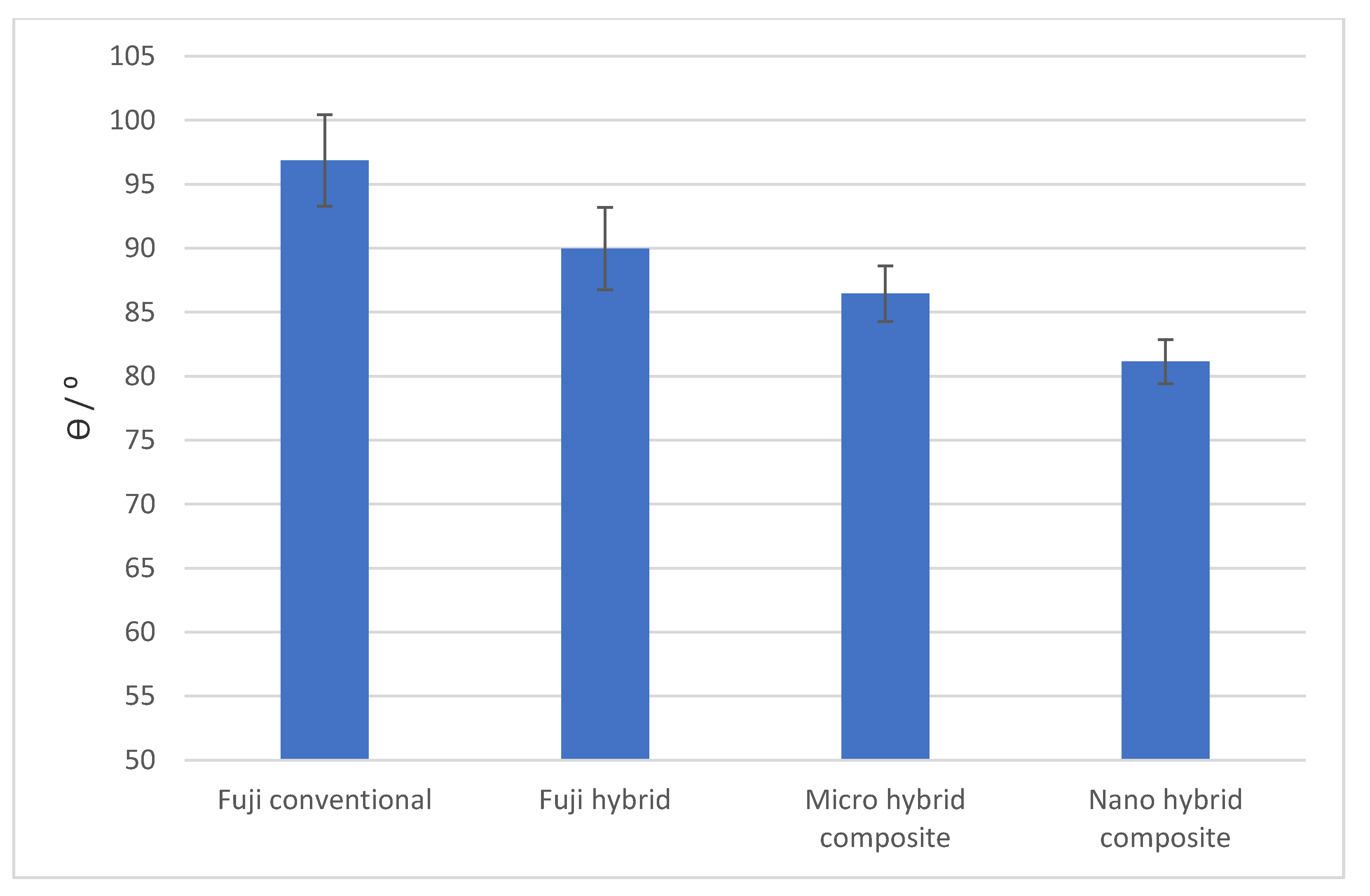
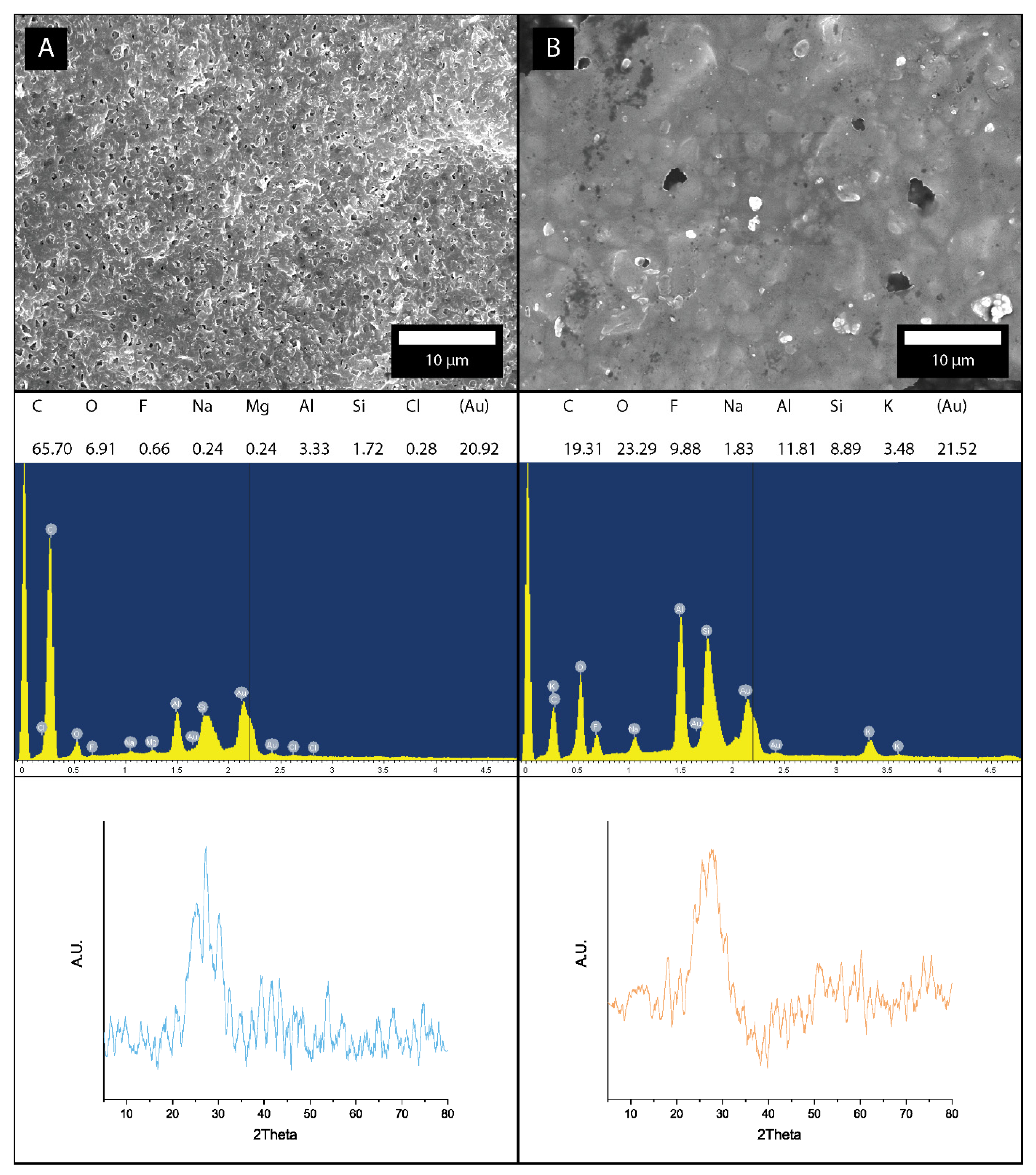
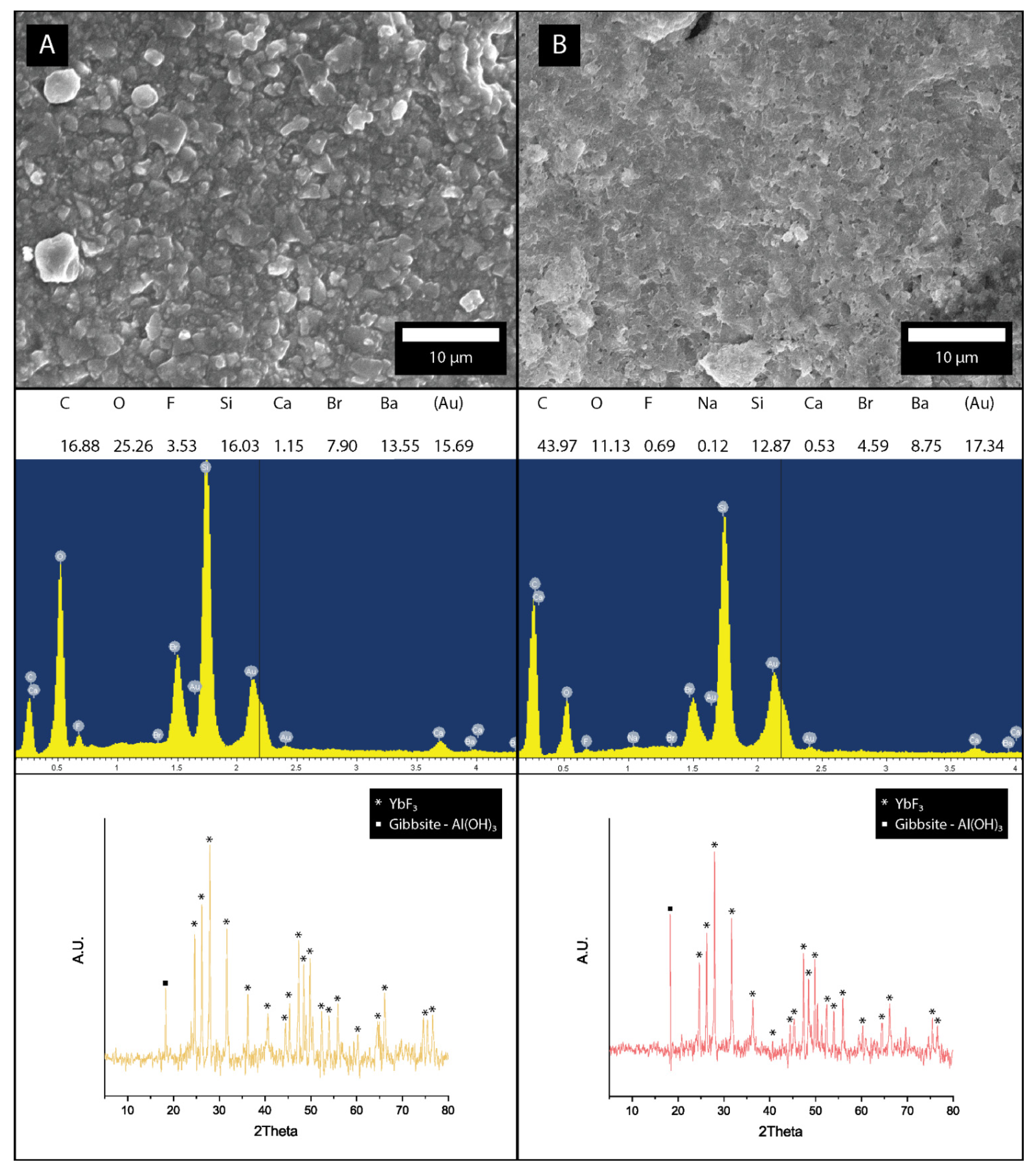
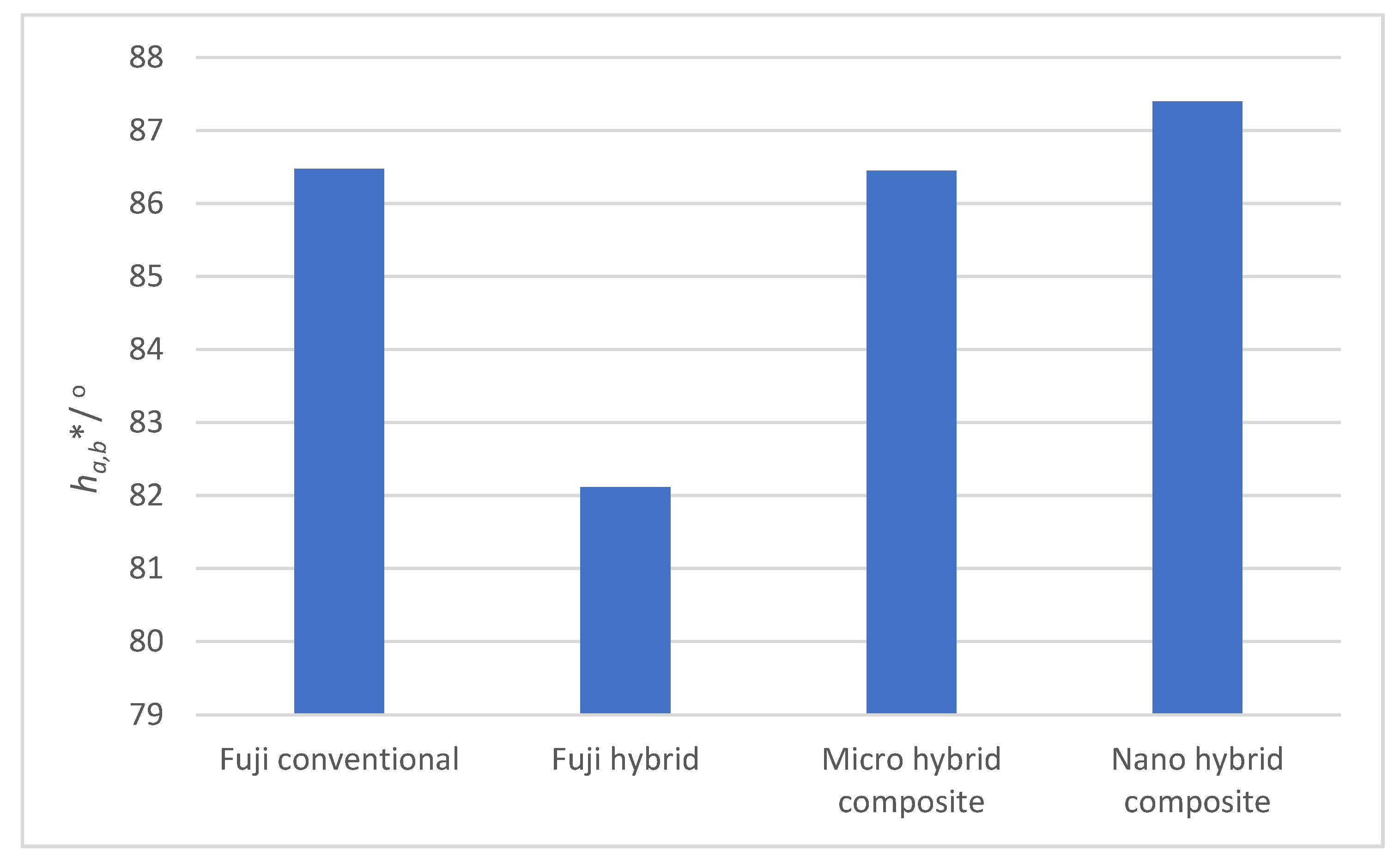
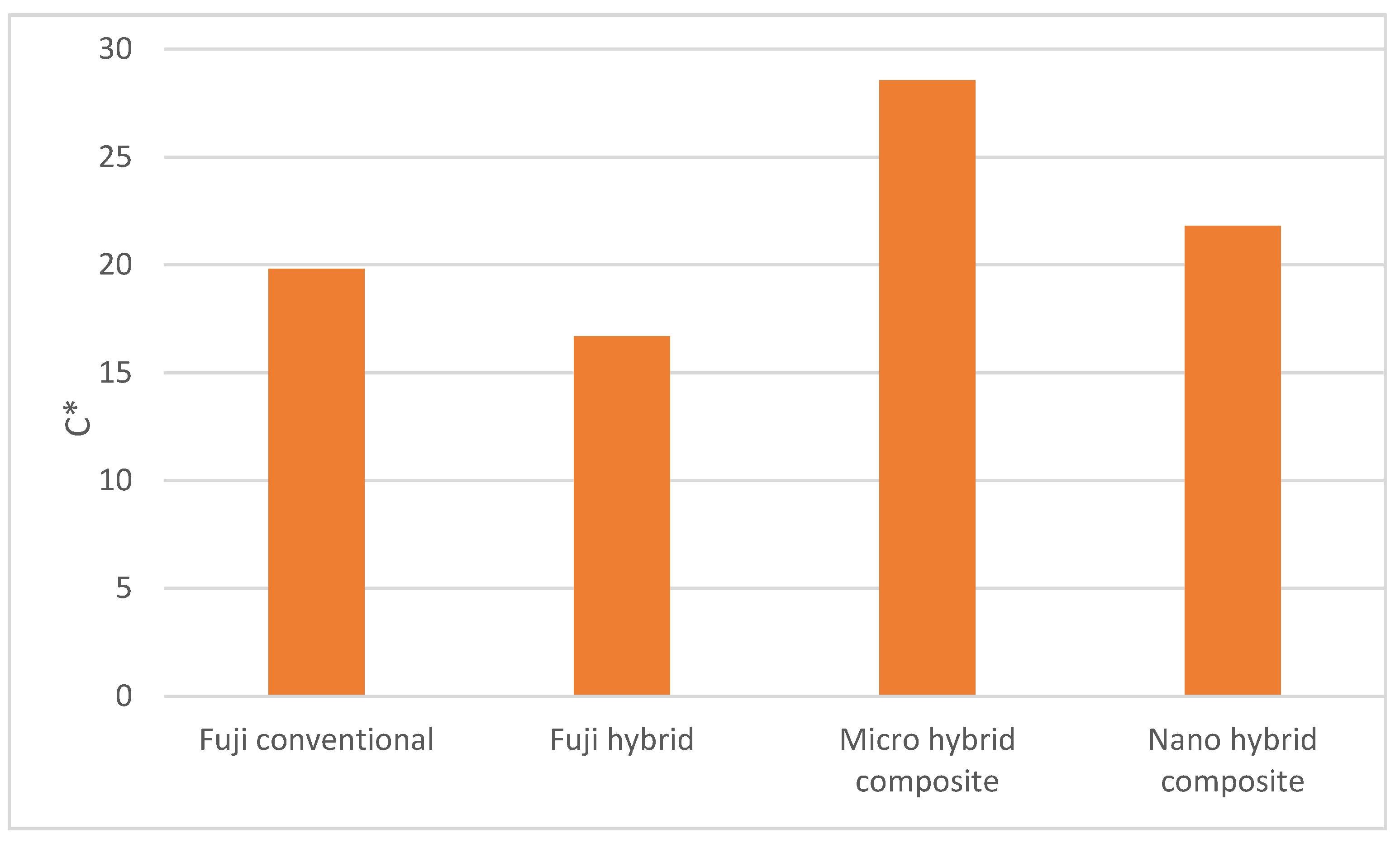

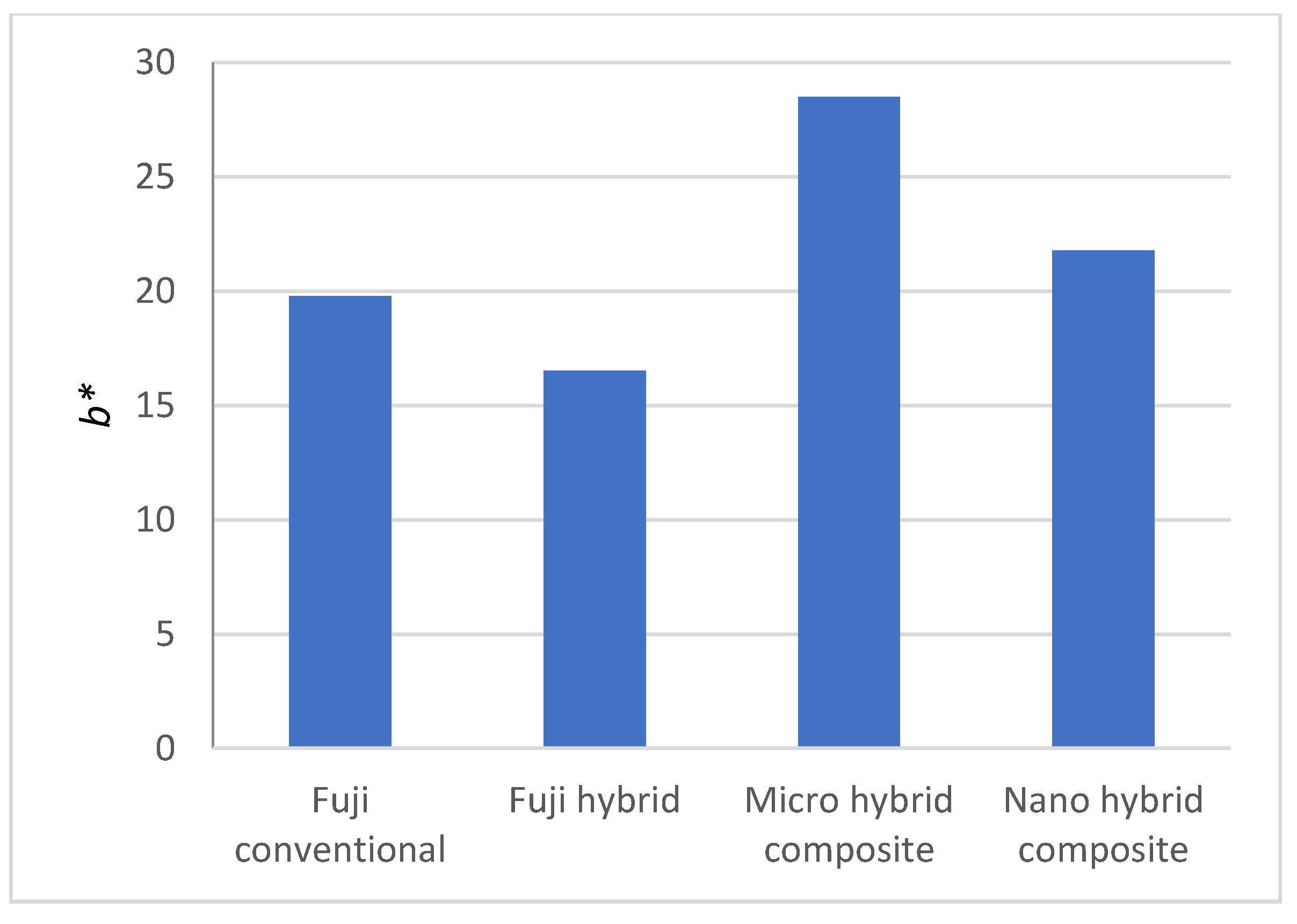
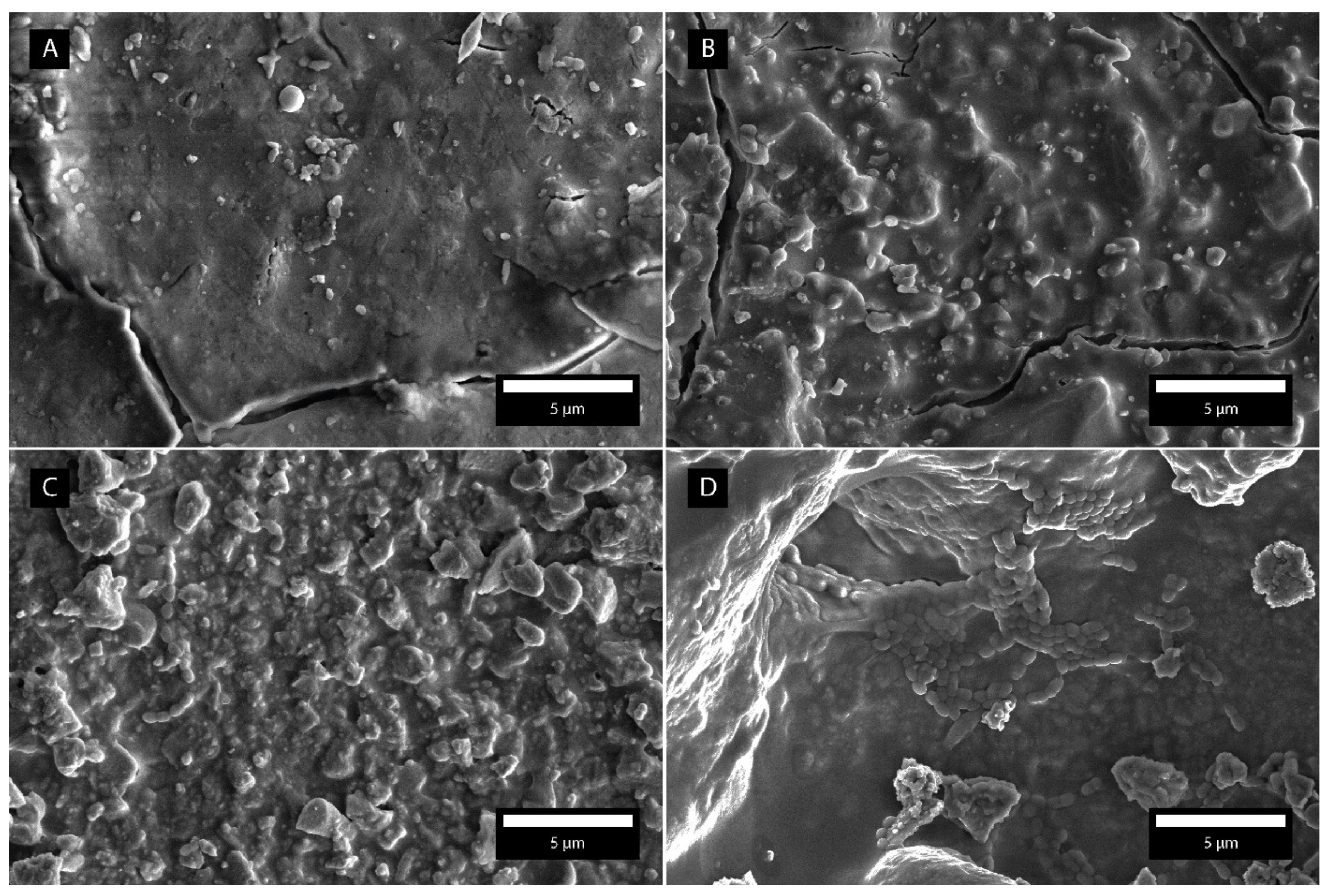
| Material | Type | Manufacturer | Composition |
|---|---|---|---|
| Fuji conventional (Fuji IX) | Glass–ionomer cement | GC (Tokyo, Japan) | Powder: 95% by weight alumino-fluoro-silicate glass with 5% polyacrylic acid powder. Liquid: 50% distilled water, 40% polyacrylic acid, and 10% polybasic carboxylic acid |
| Fuji hybrid (Fuji equia Forte glass–ionomer cements) | Glass–ionomer cement | GC (Tokyo, Japan) | Powder: 95% strontium fluoro alumino-silicate glass, 5% polyacrylic acid Liquid: 40% aqueous polyacrylic acid |
| Micro hybrid composite (TE Econom composite) | Micro hybrid composite | Ivoclar, Vivadent (Liechtenstein) | Matrix: Dimethacrylate and TEGMA (22 wt.%). Fillers: barium glass, ytterbium trifluoride, silicon dioxide and mixed oxide (76 wt.% or 60%vol) |
| Nano hybrid composite (Tetric EvoCeram composite) | Nano hybrid composite | Ivoclar, Vivadent (Liechtenstein) | bis-GMA, UDMA, ethoxylated bis-EMA, barium glass, ytterbium trifluoride, spherical mixed oxide, acyl phosphine oxide (75 wt.%) |
| Material | Zeta Potential (mV) |
|---|---|
| Fuji conventional | −21.1 ± 0.6 |
| Fuji hybrid | −20.9 ± 0.8 |
| Micro hybrid composite | −21.9 ± 1.6 |
| Nano hybrid composite | −22.2 ± 2.5 |
| Material | Bacterial Adhesion Extent/450 µm2 |
|---|---|
| Fuji conventional | 5 ± 1 |
| Fuji hybrid | 5 ± 1 |
| Micro hybrid composite | 4.33 ± 1 |
| Nano hybrid composite | 290 ± 10 |
| Fuji Conventional | Fuji Hybrid | |||||||
|---|---|---|---|---|---|---|---|---|
| Substrate | Repetition | 1 | 2 | 3 | Repetition | 1 | 2 | 3 |
| No | L* | 78.05 | 77.72 | 77.80 | L* | 79.71 | 79.75 | 79.70 |
| a* | 0.67 | 0.67 | 0.64 | a* | 0.25 | 0.22 | 0.21 | |
| b* | 14.1 | 14.24 | 14.13 | b* | 12.82 | 12.80 | 12.76 | |
| Wine | L* | 77.05 | 76.92 | 77.22 | L* | 75.17 | 75.43 | 75.69 |
| a* | 0.78 | 0.79 | 0.76 | a* | 2.42 | 2.44 | 2.39 | |
| b* | 13.6 | 13.75 | 13.77 | b* | 12.03 | 11.97 | 12.06 | |
| (ΔE) | 0.92 | (ΔE) | 3.93 | |||||
| Black tea | L* | 79.20 | 79.84 | 79.09 | L* | 80.53 | 80.78 | 80.96 |
| a* | 1.84 | 1.8 | 1.85 | a* | 1.57 | 1.52 | 1.45 | |
| b* | 16.49 | 14.44 | 16.55 | b* | 15.68 | 16.12 | 16.3 | |
| (ΔE) | 3.48 | (ΔE) | 5.92 | |||||
Publisher’s Note: MDPI stays neutral with regard to jurisdictional claims in published maps and institutional affiliations. |
© 2021 by the authors. Licensee MDPI, Basel, Switzerland. This article is an open access article distributed under the terms and conditions of the Creative Commons Attribution (CC BY) license (http://creativecommons.org/licenses/by/4.0/).
Share and Cite
Bohinc, K.; Tintor, E.; Kovačević, D.; Vidrih, R.; Zore, A.; Abram, A.; Kojić, Ž.; Obradović, M.; Veselinović, V.; Dolić, O. Bacterial Adhesion on Glass–Ionomer Cements and Micro/Nano Hybrid Composite Dental Surfaces. Coatings 2021, 11, 235. https://doi.org/10.3390/coatings11020235
Bohinc K, Tintor E, Kovačević D, Vidrih R, Zore A, Abram A, Kojić Ž, Obradović M, Veselinović V, Dolić O. Bacterial Adhesion on Glass–Ionomer Cements and Micro/Nano Hybrid Composite Dental Surfaces. Coatings. 2021; 11(2):235. https://doi.org/10.3390/coatings11020235
Chicago/Turabian StyleBohinc, Klemen, Erna Tintor, Davor Kovačević, Rajko Vidrih, Anamarija Zore, Anže Abram, Željka Kojić, Marija Obradović, Valentina Veselinović, and Olivera Dolić. 2021. "Bacterial Adhesion on Glass–Ionomer Cements and Micro/Nano Hybrid Composite Dental Surfaces" Coatings 11, no. 2: 235. https://doi.org/10.3390/coatings11020235
APA StyleBohinc, K., Tintor, E., Kovačević, D., Vidrih, R., Zore, A., Abram, A., Kojić, Ž., Obradović, M., Veselinović, V., & Dolić, O. (2021). Bacterial Adhesion on Glass–Ionomer Cements and Micro/Nano Hybrid Composite Dental Surfaces. Coatings, 11(2), 235. https://doi.org/10.3390/coatings11020235








